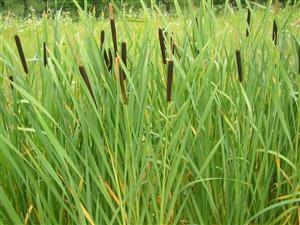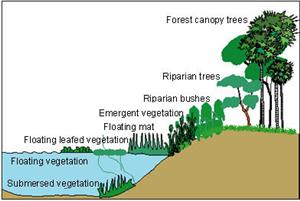Aquatic Organisms: Plants
Macrophytes
Macrophytes (literally 'large plants') are individual aquatic plants that can be seen by the unaided eye. Macrophytes can be categorized based on where and how they grow.
Rooted macrophytes are rooted in the riverbed or lake substrate, and are thus restricted to areas where flow is low enough to permit fine sediments to accumulate. Rooted macrophytes may have leaves entirely submerged (under the water), floating on the surface, or emergent above the surface. In turbid water, little light penetrates and photosynthesis is restricted, hence only plants with floating or emergent leaves can thrive. Rooted macrophytes may extract nutrients from the substrate as well as absorbing them from the water as algae do.
Floating aquatic macrophytes are rootless plants that persist only in backwater areas where the flow slackens—otherwise they are carried downstream. Because their photosynthetic surfaces are above the water surface, these plants can grow in deep, turbid water and places where rooting sites are sparse.
Macrophyte abundance can fluctuate seasonally as a result of scouring of the bottom sediments and washout of plants during heavy rains. For this reason, the number of macrophytes in river channels generally peaks during periods of low flow.
Aquatic macrophytes are important in many aquatic systems, especially wetlands, slower moving water in streams and rivers, and in shallower areas of lakes. Aquatic macrophytes add three-dimensional complexity to aquatic habitat, and can provide habitat, refuge, and spawning areas for animals such as aquatic insects and fish, as well as a surface for periphyton growth. As they are primary producers, aquatic macrophytes produce organic matter which can be eaten by some fish; however, most of this plant material is unpalatable to herbivores while it is alive. Energy is transferred to animals primarily when the dead plant tissue and associated decomposers are eaten.
Large populations of aquatic macrophytes can have negative effects on aquatic ecosystems and the people that rely on them. In some cases, floating plants are so numerous that they form dense mats covering the water surface. Their buoyant leaf crowns merge above the surface while the root masses dangle below into the water. The interlocking vegetation mat blocks light penetration down the water column and prevents the growth of other plants. In extreme cases, the underlying water becomes deoxygenated, and floating plants turn into a nuisance by inhibiting the passage of boats and interfering with fishing. Invasive species of macrophytes can be particularly disruptive to natural aquatic ecosystems.
Riparian Vegetation
Riparian vegetation is plant growth that lines the banks of rivers and other inland waterbodies. These plants protect river banks from wave action and erosion, and offer shelter, feeding, and breeding areas for fish, birds and other organisms. Leaves, twigs, and other organic matter from riparian vegetation can provide significant quantities of organic matter to streams and rivers. The riparian zone can contain a variety of plants—from grasses to trees—often in a gradual transition with distance from the bank, reflecting different species' tolerances for soil saturation.










